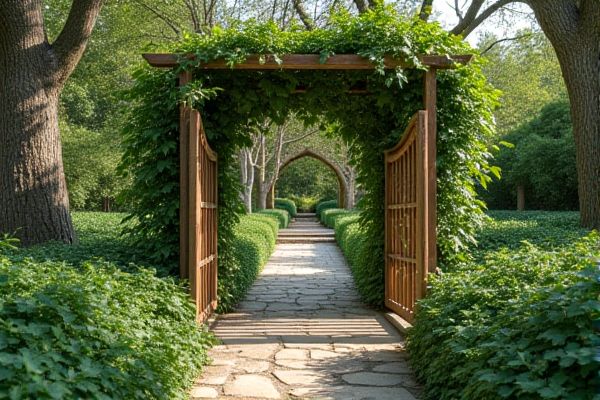
Garden trellises and garden obelisks both provide vertical support for climbing plants, but trellises typically feature a flat or lattice design ideal for spreading vines and flowers, while obelisks offer a more sculptural, three-dimensional structure that adds height and visual interest. Discover which option best suits Your garden's style and functionality by reading the full comparison in the rest of the article.
Table of Comparison
| Feature | Garden Trellis | Garden Obelisk |
|---|---|---|
| Structure Type | Flat, lattice panel | Tall, four-sided pyramid |
| Primary Use | Supporting climbing plants on walls/fences | Supporting vines & decorative in garden beds |
| Material Options | Wood, metal, plastic | Wood, metal, resin |
| Size | Varies; typically wider, less tall | Taller, narrow, vertical emphasis |
| Installation | Mounted on walls or standalone | Freestanding in garden soil |
| Decorative Aspect | Functional with minimal design | Ornamental focal point |
| Plant Compatibility | Climbers like peas, clematis | Climbers like morning glory, sweet peas |
| Durability | Depends on material; moderate | Generally sturdy; weather-resistant options |
Introduction to Garden Trellis and Garden Obelisk
Garden trellises and garden obelisks both serve as structural supports for climbing plants, enhancing vertical growth and garden aesthetics. Garden trellises usually feature a flat or slightly angled lattice design ideal for espaliering vines and vegetables, while garden obelisks are tall, four-sided, pyramid-like structures that create dramatic focal points for flowers and vines. Selecting the right option depends on your garden space and plant types, with obelisks providing height and visual interest and trellises offering practical support for espaliered plants.
Key Differences Between Trellis and Obelisk
A garden trellis typically features a flat, lattice structure designed for supporting climbing plants and maximizing vertical growth, while a garden obelisk offers a three-dimensional, pyramid-like frame that provides multifaceted support and visual interest. Trellises are commonly mounted against walls or fences, whereas obelisks stand independently in garden beds, enhancing both functionality and garden aesthetics. The materials differ as well, with trellises often made from wood or metal designed for spreading vines, and obelisks crafted for climbing plants to spiral upward, adding structural elegance.
Design and Aesthetic Appeal
Garden trellises feature flat or lattice designs that provide ample vertical support for climbing plants, enhancing the garden's texture and structure. Garden obelisks, characterized by their tall, narrow, four-sided tapered shape, offer an elegant focal point that adds vertical interest and a classical aesthetic. Both structures can be crafted from materials like wood, metal, or vinyl, allowing for versatile styles that complement various garden themes while supporting plant growth.
Structural Functionality
A garden trellis provides structural support for climbing plants through a flat, lattice-like framework that encourages horizontal growth and spreading. In contrast, a garden obelisk features a vertical, pyramid-shaped structure designed to support vines and tall plants, enhancing vertical space utilization in your garden. Choosing between the two depends on your garden's spatial needs and the growth habits of your plants.
Space and Placement Considerations
Garden trellises are ideal for narrow spaces, allowing vertical growth against walls or fences, maximizing your garden's limited area. Garden obelisks provide a freestanding structure that can be placed anywhere, serving as a focal point or centerpiece in larger garden beds. Choosing between them depends on your available space and desired placement flexibility for climbing plants.
Plant Compatibility and Support
Garden trellises offer extensive vertical support ideal for climbing plants such as clematis, morning glories, and cucumbers, promoting healthy growth and maximizing space. Garden obelisks provide a more compact structure, perfect for supporting flowering vines like sweet peas and climbing roses while adding decorative height to smaller garden areas. Both structures enhance plant vitality by stabilizing stems and improving air circulation, but selection depends on plant type and available garden space.
Material Durability and Maintenance
Garden trellises made from metal or cedar wood offer excellent durability and require minimal maintenance, resisting weather damage and pests effectively. Garden obelisks, often constructed from wrought iron or hardwood, provide strong support for climbing plants but may need occasional rust-proofing or sealing to maintain their longevity. Choosing the right structure depends on your garden's exposure to elements and how much maintenance you're willing to perform to keep your plants supported beautifully.
Installation and Setup Process
Garden trellises typically require straightforward installation, often involving simple mounting against a wall or staking into the ground, making them ideal for climbing plants like vines and vegetables. Garden obelisks demand a more careful setup to ensure stability, usually involving securing the base firmly into the soil to support heavier or taller plants such as roses and clematis. Both structures benefit from proper placement in sunlight and soil preparation to optimize plant growth and longevity.
Cost Comparison: Trellis vs Obelisk
Garden trellises generally cost less than garden obelisks due to simpler designs and materials like wood or metal lattice, with prices ranging from $20 to $75. Garden obelisks, often crafted from heavier steel or wrought iron with intricate details, typically range from $50 to $150, reflecting higher durability and decorative value. Budget-conscious gardeners often prefer trellises for affordability, while those seeking aesthetic impact may invest more in obelisks.
Choosing the Right Structure for Your Garden
Garden trellises provide a versatile, horizontal support system ideal for sprawling vines and vegetables, maximizing garden space and promoting healthy plant growth. Garden obelisks offer a vertical, decorative focal point, perfect for climbing flowers and adding height to garden beds. Your choice depends on the plant type and garden aesthetic, ensuring the structure complements both functionality and visual appeal.
 homyna.com
homyna.com